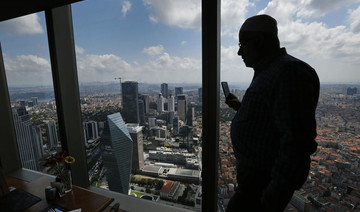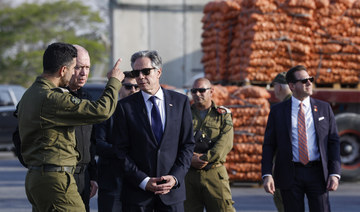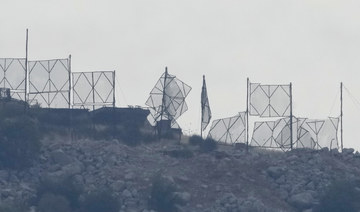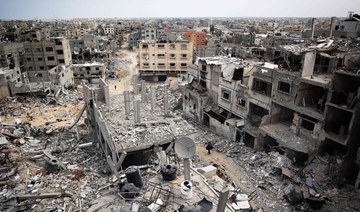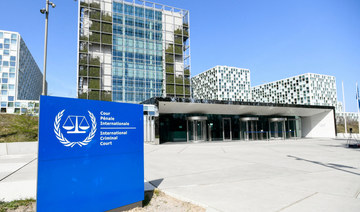DUBAI: With the rise of modern cities across the Gulf, the region is taking vital steps to safeguard its culture and heritage.
Saudi Arabia made another move towards preservation this week with an agreement to protect intangible cultural heritage. The partnership, between the General Culture Authority and the Saudi Heritage Preservation Society in Riyadh, will document elements of heritage across the Kingdom to protect, enrich and promote its culture.
According to UNESCO, intangible heritage is made up of oral traditions, performing arts, social practices, rituals and festive events, knowledge and practices concerning nature and the universe, and traditional craftsmanship knowledge and techniques. The region is also adding areas to the organization’s World Heritage list, which designates landmarks of cultural, historical or scientific significance.
Even while the more ancient aspects of Gulf countries’ heritage are being preserved, some are looking to a much shorter definition of history, as a wave of futuristic buildings in the GCC has put more recent buildings at risk of demolition. Last month, Dubai Municipality launched the “Modern Heritage Initiative” to preserve the emirate’s landmark buildings from the 1960s and 1970s, including one of the first skyscrapers, the Dubai World Trade Center, and the Clock Tower in Deira.
“The Gulf states need to recognize the value that the modern architecture holds in a historical context and for those of us who grew up between the 1960s and 1980s,” said Sultan Sooud Al-Qassemi, director’s fellow at MIT Media Lab and founder of Barjeel Art Foundation, a significant collection of Arab art based in Sharjah. “These buildings tell countless stories of the immigrants and the residents who made the UAE and the Gulf their homes.”
From the Al-Sawaber residential complex in Kuwait City, built in 1981 by Arthur Erickson, to the Al-Fahidi and Al-Shindagha Historical Neighborhoods in Dubai, as well as the historical Al-Balad district in Jeddah, protecting the old is becoming a priority.
“The structures with which we recognize major American cities like Miami, New York or Chicago gained more value as time passed and became tourist attractions,” Al-Qassemi said. “The same will happen with our 1960s and 1970s buildings if we only protect them.”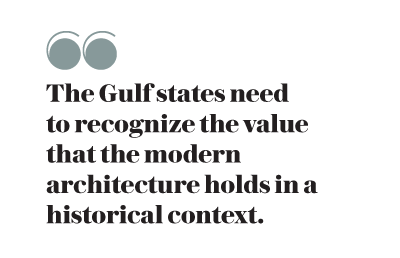
Last month, 90 buildings in Abu Dhabi were identified by the municipality for demolition. The buildings were said to either be abandoned or ageing, posing a threat to public health and safety.
But in a region as young as the Gulf, older buildings are viewed as precious gems to preserve. “It’s important for the Gulf and for the world to preserve historic buildings and traditional architecture because it is part of the countries’ history and civilization, much like the Pyramids in Egypt, the Wall of China and the Taj Mahal,” said Rashad Bukhash, chair of the Architectural Heritage Society in the UAE. “It’s the sign of architecture, people who lived in that area, and the economy. It also shows how they lived and the architecture, which coming generations can learn from.”
Bukhash, who has 30 years of experience in the field of managing and supervising modern architectural projects and conserving historic buildings, spoke of plans for green and sustainable architecture. “This is what we are now looking for,” he said. “But with the architecture we had in the 1950s, there was no use of energy and we used natural ventilation and sunlight, so it’s 100 per cent sustainable. We shouldn’t go back but we have to learn from that because people in the 1950s didn’t have electricity, so they innovated, using materials such as coral, stone, mud and gypsum.”
He called for increasing use of natural resources, including the sun and wind, to move towards a greener architecture. “With a lot of modern architecture coming up everywhere in Gulf cities, the situation today is much better than 10 or 20 years ago when we had a lot of buildings and districts being demolished,” Bukhash said. “Nowadays, in most Gulf cities, there are legislations for the protection of historic buildings, whether in the UAE, Bahrain, Qatar, Saudi Arabia or Oman.”
 Experts believe the trend is shifting towards preservation rather than demolition. “In Dubai, the municipality recently took the decision to start restoring 1960s buildings, which is a good sign,” Bukhash said. “We can’t compare historic Dubai from 1950 to the urban city of Dubai nowadays, which is less than 1 percent of the area, because it developed very quickly. The old part has been kept and protected with legislations and we are hopefully on the right track.”
Experts believe the trend is shifting towards preservation rather than demolition. “In Dubai, the municipality recently took the decision to start restoring 1960s buildings, which is a good sign,” Bukhash said. “We can’t compare historic Dubai from 1950 to the urban city of Dubai nowadays, which is less than 1 percent of the area, because it developed very quickly. The old part has been kept and protected with legislations and we are hopefully on the right track.”
Old architecture is defined by local materials, such as mud, wood and stone, while modern architecture focuses on concrete, steel and wood. “Protecting these fragile structures is a priority and is actually the biggest challenge facing urban planners and architects,” said Samir Saddi, founder and director of the Arab Research Center for Architecture and Design of the Environment. “The reason lies behind financial considerations since the huge developments, which are mostly speculative, rely on land acquisition and, most of the time, in historic sites or old neighborhoods. Hence, we witness this dilemma that owners of these old structures face today: to keep or to sell, in other words to continue living in old and ancestral buildings or to sell and move to modern facilities.”
He said preserving old urban settlements and structures can be done through creating legislation and bylaws that classify old cities, urban neighborhoods or structures, and prohibits their demolition. “Other ways include changing the usage of these buildings and transforming their interior spaces into new functions while keeping but renovating their elevations,” Saddi said. “Integrating these structures into contemporary developments that respect their scale and architectural dimensions is another approach that is mostly used in Europe nowadays.”
For Saddi, who devoted more than 45 years to documenting traditional and modern architecture in Africa and the Arab world, a city without its traditional urban neighborhoods or buildings is a city without soul. “We are building cities in the Arab world that have no soul and no reference to a past, no character or no continuity with what the ancestors have built,” he said. “This creates mediocre and uniform architecture that will look like any other in different places or countries. I documented a large number of historic buildings in the Arab word, mainly in Saudi Arabia, where I spent years taking photos of Old Jeddah’s amazing architecture.”
In 2000, he contacted the Saudi Ambassador in UNESCO, Paris, to ask that Old Jeddah be put on the World Heritage list. “It took 13 years for this to happen. In the meantime, a lot of historic buildings were lost. I did an exhibition in the Empty Quarter a couple of years back as a tribute to some of these buildings that I recorded but that physically disappeared.”
Jacqui Shaddock, design director and partner at H2R Design, said the Gulf region has changed rapidly over the past few decades. “The influx of people, cultures and commercial activities has been at much higher velocity than was the case in other cities, in Europe for instance,” she said.
“This means it is vital to act just as swiftly with the protection and preservation of the rich cultural heritage that is being swamped. As well as physically protecting existing buildings and historical sites, we see the importance of celebrating and teaching regional artisan craftsmanship, and exploring locally available materials, to ensure that even new builds retain a respectful nod to the heritage of the area rather than competing with it.”
Rising Gulf cities look to protect landmarks
Rising Gulf cities look to protect landmarks
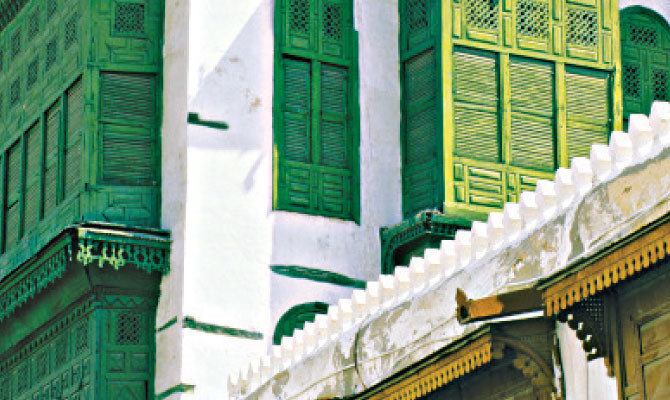
- Experts believe the trend is shifting towards preservation rather than demolition
- Old architecture is defined by local materials, such as mud, wood and stone, while modern architecture focuses on concrete, steel and wood
Rafah incursion would put hundreds of thousands of lives at risk, UN aid agency says
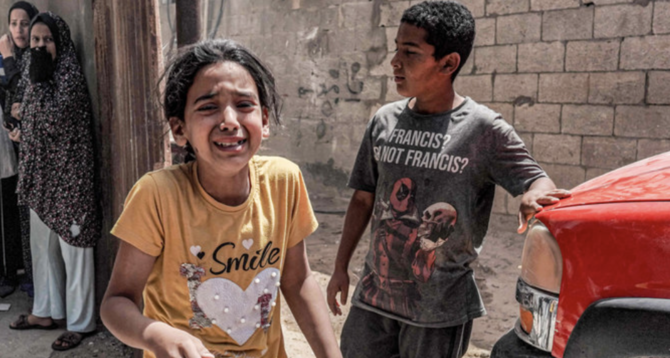
- Leaders internationally have urged Israeli Prime Minister Benjamin Netanyahu to be cautious
- US Defense Secretary Lloyd Austin said any US response to incursion would be up to President Biden
GAZA: The United Nations humanitarian aid agency says hundreds of thousands of people would be “at imminent risk of death” if Israel carries out a military assault in the southern Gaza city of Rafah.
The city has become critical for humanitarian aid and is highly concentrated with displaced Palestinians.
Leaders internationally have urged Israeli Prime Minister Benjamin Netanyahu to be cautious about any incursion into Rafah, where seven people — mostly children — were killed overnight in an Israeli airstrike.
On Thursday, US Defense Secretary Lloyd Austin said any US response to such an incursion would be up to President Joe Biden, but that currently, “conditions are not favorable to any kind of operation.”
Turkiye’s trade minister said Friday that its new trade ban on Israel was in response to “the deterioration and aggravation of the situation in Rafah.”
The Israel-Hamas war has driven around 80 percent of Gaza’s population of 2.3 million from their homes, caused vast destruction in several towns and cities, and pushed northern Gaza to the brink of famine.
The death toll in Gaza has soared to more than 34,500 people, according to local health officials, and the territory’s entire population has been driven into a humanitarian catastrophe.
The war began Oct. 7 when Hamas attacked southern Israel, abducting about 250 people and killing around 1,200, mostly civilians. Israel says militants still hold around 100 hostages and the remains of more than 30 others.
Dozens of people demonstrated Thursday night outside Israel’s military headquarters in Tel Aviv, demanding a deal to release the hostages. Meanwhile, Hamas said it would send a delegation to Cairo as soon as possible to keep working on ceasefire talks. A leaked truce proposal hints at compromises by both sides after months of talks languishing in a stalemate.
Across the US, tent encampments and demonstrations against the Israel-Hamas war have spread across university campuses.
More than 2,000 protesters have been arrested over the past two weeks as students rally against the war’s death toll and call for universities to separate themselves from any companies that are advancing Israel’s military efforts in Gaza.
Iraqi militant group claims missile attack on Tel Aviv targets, source says

- The attack was carried out with multiple Arqub-type cruise missiles
BAGHDAD: The Islamic Resistance in Iraq, a group of Iran-backed armed groups, launched multiple attacks on Israel using cruise missiles on Thursday, a source in the group said.
The source told Reuters the attack was carried out with multiple Arqub-type cruise missiles and targeted the Israeli city of Tel Aviv for the first time.
The Islamic Resistance in Iraq has claimed dozens of rockets and drone attacks on US forces in Iraq and Syria and on targets in Israel in the more than six months since the Israel-Hamas war erupted on Oct. 7.
Israel has not publicly commented on the attacks claimed by Iraqi armed groups.
15 pro-government Syrian fighters killed in Daesh attacks: monitor

- It is the latest attack of its kind by remnants of the jihadists
BEIRUT: Daesh group militants killed at least 15 Syrian pro-government fighters on Friday after they attacked three military positions in the Syrian desert, a war monitor said.
It is the latest attack of its kind by remnants of the jihadists.
They “attacked three military sites belonging to regime forces and fighters loyal to them... in the eastern Homs countryside, triggering armed clashes... and killing 15” pro-government fighters, the British-based Syrian Observatory for Human Rights said.
Daesh overran large swathes of Syria and Iraq in 2014, proclaiming a so-called caliphate and launching a reign of terror.
It was defeated territorially in Syria in 2019, but its remnants continue to carry out deadly attacks, particularly against pro-government forces and Kurdish-led fighters in the vast desert.
Daesh remnants are also active in neighboring Iraq.
Last month, Daesh fighters killed 28 Syrian soldiers and affiliated pro-government forces in two attacks on government-held areas of Syria, the Observatory said.
Many were members of the Quds Brigade, a group comprising Palestinian fighters that has received support from Damascus ally Moscow in recent years, according to the Observatory, which has a network of sources inside Syria.
In one of those attacks, the jihadists fired on a military bus in eastern Homs province, the Observatory said at the time.
Separately, six Syrian soldiers died in an Daesh attack against a base in eastern Syria, it added.
Syria’s war has claimed the lives of more than half a million people and displaced millions more since it erupted in March 2011 with Damascus’s brutal repression of anti-government protests.
It then pulled in foreign powers, militias and jihadists.
In late March, Daesh militants “executed” eight Syrian soldiers after an ambush, the monitor said at that time.
The jihadists also target people hunting desert truffles, a delicacy which can fetch high prices in the war-battered economy.
The Observatory in March said Daesh had killed at least 11 truffle hunters by detonating a bomb as their car passed in the desert of Raqqa province in northern Syria.
In separate unrest in the country, Syria’s defense ministry earlier on Friday said eight soldiers had been injured in Israeli air strikes near Damascus.
The Observatory said Israel had struck a government building in the Damascus countryside that has been used by Lebanon’s Iran-backed Hezbollah group since 2014.
The Israeli military has carried out hundreds of strikes in Syria since the outbreak of Syria’s civil war, mainly targeting army positions and Iran-backed fighters.
Prominent Gaza doctor killed by torture in Israeli detention

- Al-Bursh died in Ofer Prison, an Israeli-run incarceration facility in the West Bank, says the Palestinian Prisoners Society
GAZA: Adnan Al-Bursh, a Palestinian surgeon and former head of orthopedics at Gaza’s Al-Shifa medical complex, was killed on April 19 under torture in Israeli detention.
According to a statement from the Palestinian Prisoners Society, Al-Bursh, 50, died in Ofer Prison, an Israeli-run incarceration facility in the West Bank.
His body remains held by the Israeli authorities, according to the Palestinian Civil Affairs Committee.
The Palestinian Prisoners Society described the doctor’s death in Israeli custody as “assassination.”
Al-Bursh, who was a prominent surgeon in Gaza’s largest hospital Al-Shifa, was reportedly working at Al-Awada Hospital in the northern Gaza Strip when he was arrested by Israeli forces.
The Israeli prison service declared Al-Bursh dead on April 19, claiming the doctor was detained for “national security reasons.”
However, the prison’s statement did not provide details on the cause of death. A prison service spokesperson said the incident was being investigated.
Francesca Albanese, the UN special rapporteur on the occupied Palestinian territories, said on Thursday she was “extremely alarmed” at the death of the Palestinian surgeon.
“I urge the diplomatic community to intervene with concrete measures to protect Palestinians. No Palestinian is safe under Israel’s occupation today,” she wrote on X.
I am extremely alarmed by information that Dr. Adnan Albursh, a well-known surgeon at #alshifa_hospital, has died while detained by Israeli forces in the Ofer military prison. While I acquire more information, I URGE the diplomatic community to intervene with CONCRETE MEASURES to…
— Francesca Albanese, UN Special Rapporteur oPt (@FranceskAlbs) May 2, 2024
Since Oct. 7, when Israel launched its retaliatory bombing campaign in the Gaza Strip, the Israeli military has carried out over 435 attacks on healthcare facilities in the besieged Palestinian enclave, killing at least 484 medical staff, according to UN figures.
However, the health authority in Gaza said in a statement that Al-Bursh’s death has raised the number of healthcare workers killed in the ongoing onslaught on the strip to 496.
Palestinian prisoner organizations report that the Israeli army has detained more than 8,000 Palestinians from the West Bank alone since Oct. 7. Of those, 280 are women and at least 540 are children.
ICC prosecutor calls for end to intimidation of staff, statement says

- The ICC prosecutor’s office said all attempts to impede, intimidate or improperly influence its officials must cease immediately
- The statement followed Israeli and American criticism of the ICC’s investigation into alleged war crimes committed during the Israel-Hamas conflict in Gaza
AMSTERDAM: The International Criminal Court’s prosecutor’s office called on Friday for an end to what it called intimidation of its staff, saying such threats could constitute an offense against the world’s permanent war crimes court.
In the statement posted on social media platform X, the ICC prosecutor’s office said all attempts to impede, intimidate or improperly influence its officials must cease immediately. It added that the Rome Statute, which outlines the ICC’s structure and areas of jurisdiction, prohibits these actions.
The statement, which named no specific cases, followed Israeli and American criticism of the ICC’s investigation into alleged war crimes committed during the Israel-Hamas conflict in the Gaza Strip, a Palestinian enclave.
Neither Israel nor its main ally the US are members of the court, and do not recognize its jurisdiction over the Palestinian territories. The court can prosecute individuals for alleged war crimes, crimes against humanity and genocide.
Last week Israel voiced concern that the ICC could be preparing to issue arrest warrants for government officials on charges related to the conduct of its war against Hamas in Gaza.
Foreign Minister Israel Katz said Israel expected the ICC to “refrain from issuing arrest warrants against senior Israeli political and security officials,” adding: “We will not bow our heads or be deterred and will continue to fight.”
On Friday, Israeli Prime Minister Benjamin Netanyahu said any ICC decisions would not affect Israel’s actions but would set a dangerous precedent.
In October, ICC Chief Prosecutor Karim Khan said it had jurisdiction over any potential war crimes committed by Hamas fighters in Israel and by Israeli forces in Gaza, which has been ruled by Hamas since 2007.
A White House spokesperson said on Monday the ICC had no jurisdiction “in this situation, and we do not support its investigation.”






